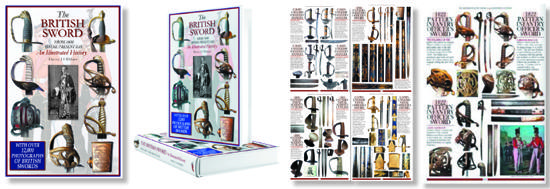
THE ENGLISH HUNTING SWORD of the 17th Century is a good example of how a sword type designed primarily for one function i.e. the despatching and butchering of an animal, was subsequently adopted for use in a range of non-hunting areas, becoming a popular choice of sword for the hunter, civilian, infantry soldier and naval officer. The English huntsman carried a short sword or hanger as his primary hunting weapon well into the 17th Century, in contrast to his continental neighbours, who quickly discarded the sword in favour of the firearm. This may have been due partly to the nature of the animals pursued. In England, the deer and hare (and occasionally, the boar) were the main quarry but on the continent, the huntsman had to face wolves, bears and boars. It is no wonder that they chose to wait in hides and take potshots from a relatively safe distance. In these countries, the hunting sword developed into an elaborate and fashionable accoutrement to their dress, rather than a practical hunting tool. The hunting sword of this period is also commonly described as a hirschfänger, or couteaux-de-chasse (anglicised into “cuttoes”). In England, the hunting hanger was used as it was originally intended and the following contemporary description is typical of the gruesome rituals involved after a deer had been caught.
“…the Huntsman presents the Person that took the Essay with a drawn Hanger, to have a Chop at his Head, and after him, every one hath a Chop if it is not cut off; and generally the Huntsman, or Keeper is provided with such a Hanger, that is not over Sharp, that there may be the more Chops for the gaining more Fees, every one giving him a Shilling at least.”
English infantry hangers have been discussed in a previous chapter and it is apparent upon even scant observation, that a number of infantry sword styles are simply hunting swords adopted for use by the infantry. The same applies to naval officer’s hangers of this period. It can therefore become quite difficult to say without hesitation that a hanger was definitely used in the field of hunting or on the field of battle. The hanger was very much a multi-purpose, edged weapon of the period. What we can say with confidence is that a distinctive “hunting” hanger style was developed in England during the 17th Century and an important location for manufacture of these hangers was the Hounslow sword manufactory, near London. Mention has already been made of the history of this business venture so we will concentrate on describing the hunting sword styles produced at Hounslow.
Hounslow hangers ranged in style from very plain, iron hilts with minimal, chiselled decoration, to silver encrusted pieces of excellent workmanship. Most exhibit flattened pommels and scrolled peaks that receive the knucklebow. Shell guards are normally of trefoil shape and frequently pierced, with quillons of downward, drooping form and globular finials. Grips are almost always made from staghorn, although more expensive materials such as ivory are encountered. Blades tend to be slightly curved and double-edged, with some having a sawback edge. A number are engraved with Hounslow maker marks and occasionally dated.
As the century progressed, English hunting hangers became more uniform in style and the materials used in the manufacture of hilts changed from iron to brass and silver. This was due primarily to the cheapness and easier workability of brass and silver but the transition was not without its problems. The main opposition to using these materials came from the London Cutlers Company who had traditionally worked with iron. They quickly realised that foreign and English-made cast brass hilts could be produced in greater quantities and much more cheaply than their harder to work, iron-hilted swords, and saw an immediate threat to their livelihoods. These Guilds worked within the confines of the city and deliberately misinterpreted a Royal Proclamation of the 1630’s, prohibiting the manufacture of brass goods, saying that:“Buckles which are cast in Brasse, are brittle, and not so serviceable as those made of Iron”. The Company decided that they would also apply this ban to sword hilts and any associated parts. In 1650, they declared that “…all hilts pomells and handles cast in brasse or anything else belongeing to a sword, rapier, dagger, hanger and skeyne are unserviceable, deceiptful and unlawful wares”. Interestingly, the writ of this guild only applied within the city of London and the Hounslow sword manufactory (being located outside London) was not affected by the Guild. This must have been extremely frustrating for the Guild as it was manufacturers like Hounslow that they wished to target and felt most threatened by.
Ultimately, it was not private manufacturers that the Cutlers Company had to fear, but the Government, in the form of the Board of Ordnance, who had quickly realised that brass-hilted weapons were considerably cheaper and quicker to produce than their iron counterparts. With the need to equip a growing standing army as cheaply as possible, brass was always going to win through over iron.
© Harvey Withers Military Publishing, 2024
Taken from The British Sword – From 1600 to the Present Day – An Illustrated History by Harvey J S Withers – 12,000 full colour photographs – 884 pages
For more details please click on the images.

